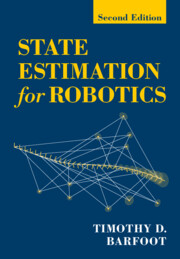Book contents
- Frontmatter
- Contents
- Preface for the First Edition
- Preface for the Second Edition
- Acronyms and Abbreviations
- Notation
- 1 Introduction
- Part I Estimation Machinery
- Part II Three-Dimensional Machinery
- 7 Primer on Three-Dimensional Geometry
- 8 Matrix Lie Groups
- Part III Applications
- Part IV Appendices
- References
- Index
8 - Matrix Lie Groups
from Part II - Three-Dimensional Machinery
Published online by Cambridge University Press: 11 January 2024
- Frontmatter
- Contents
- Preface for the First Edition
- Preface for the Second Edition
- Acronyms and Abbreviations
- Notation
- 1 Introduction
- Part I Estimation Machinery
- Part II Three-Dimensional Machinery
- 7 Primer on Three-Dimensional Geometry
- 8 Matrix Lie Groups
- Part III Applications
- Part IV Appendices
- References
- Index
Summary
Rotational state variables are a problem for our estimation tools from earlier chapters, which all assumed the state to be estimated was a vector in the sense of linear algebra. Rotations cannot be globally described as vectors and as such must be handled with care. This chapter re-examines rotations as an example of a Lie group, which has many useful properties despite not being a vector space. The main takeaway of the chapter is that in estimation we can use the Lie group structure to adapt our estimation tools to work with rotations, and by association poses. The key is to consider small perturbations to rotations in the group's Lie algebra in order to make two tasks easier to handle: performing numerical optimization and representing uncertainty. The chapter can also serve as a useful reference for readers already familiar with the content.
- Type
- Chapter
- Information
- State Estimation for RoboticsSecond Edition, pp. 256 - 344Publisher: Cambridge University PressPrint publication year: 2024

